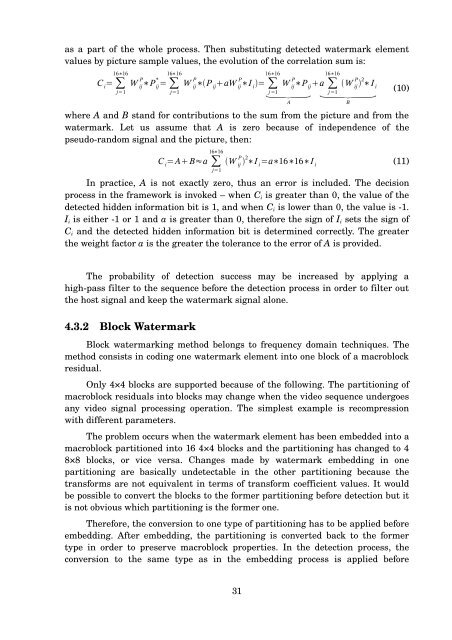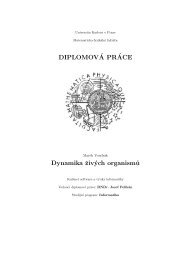MASTER THESIS Video Watermarking - Computer Graphics Group ...
MASTER THESIS Video Watermarking - Computer Graphics Group ...
MASTER THESIS Video Watermarking - Computer Graphics Group ...
Create successful ePaper yourself
Turn your PDF publications into a flip-book with our unique Google optimized e-Paper software.
as a part of the whole process. Then substituting detected watermark element<br />
values by picture sample values, the evolution of the correlation sum is:<br />
<br />
<br />
<br />
<br />
<br />
<br />
<br />
where A and B stand for contributions to the sum from the picture and from the<br />
watermark. Let us assume that A is zero because of independence of the<br />
pseudo-random signal and the picture, then:<br />
<br />
In practice, A is not exactly zero, thus an error is included. The decision<br />
process in the framework is invoked – when Ci is greater than 0, the value of the<br />
detected hidden information bit is 1, and when Ci is lower than 0, the value is -1.<br />
Ii is either -1 or 1 and a is greater than 0, therefore the sign of Ii sets the sign of<br />
Ci and the detected hidden information bit is determined correctly. The greater<br />
the weight factor a is the greater the tolerance to the error of A is provided.<br />
The probability of detection success may be increased by applying a<br />
high-pass filter to the sequence before the detection process in order to filter out<br />
the host signal and keep the watermark signal alone.<br />
4.3.2 Block Watermark<br />
<br />
<br />
<br />
<br />
<br />
<br />
<br />
<br />
<br />
Block watermarking method belongs to frequency domain techniques. The<br />
method consists in coding one watermark element into one block of a macroblock<br />
residual.<br />
Only 4×4 blocks are supported because of the following. The partitioning of<br />
macroblock residuals into blocks may change when the video sequence undergoes<br />
any video signal processing operation. The simplest example is recompression<br />
with different parameters.<br />
The problem occurs when the watermark element has been embedded into a<br />
macroblock partitioned into 16 4×4 blocks and the partitioning has changed to 4<br />
8×8 blocks, or vice versa. Changes made by watermark embedding in one<br />
partitioning are basically undetectable in the other partitioning because the<br />
transforms are not equivalent in terms of transform coefficient values. It would<br />
be possible to convert the blocks to the former partitioning before detection but it<br />
is not obvious which partitioning is the former one.<br />
Therefore, the conversion to one type of partitioning has to be applied before<br />
embedding. After embedding, the partitioning is converted back to the former<br />
type in order to preserve macroblock properties. In the detection process, the<br />
conversion to the same type as in the embedding process is applied before<br />
31<br />
<br />
<br />
<br />
<br />
<br />
<br />
<br />
<br />
(10)<br />
(11)
















